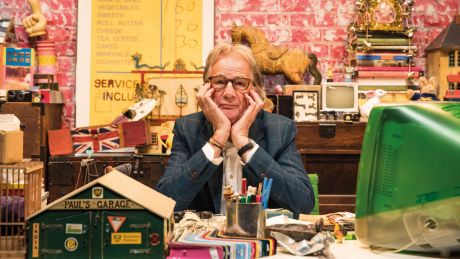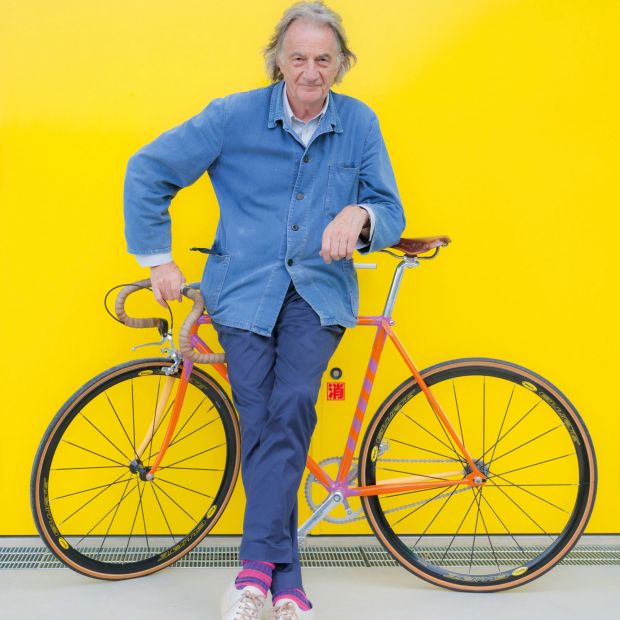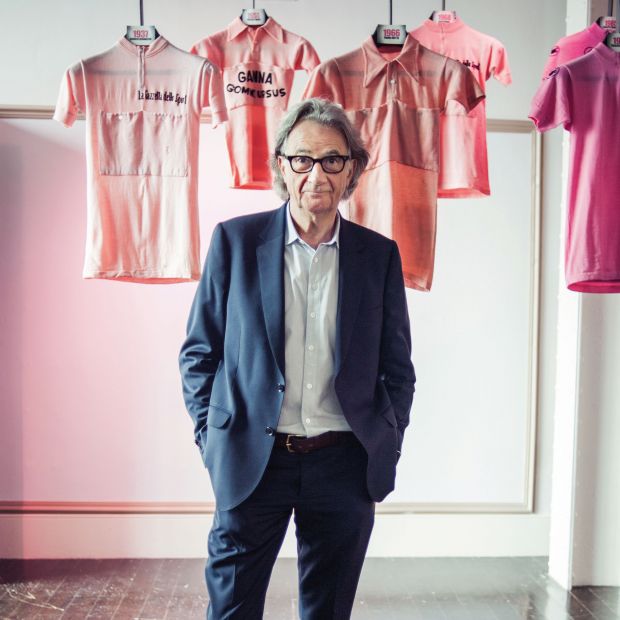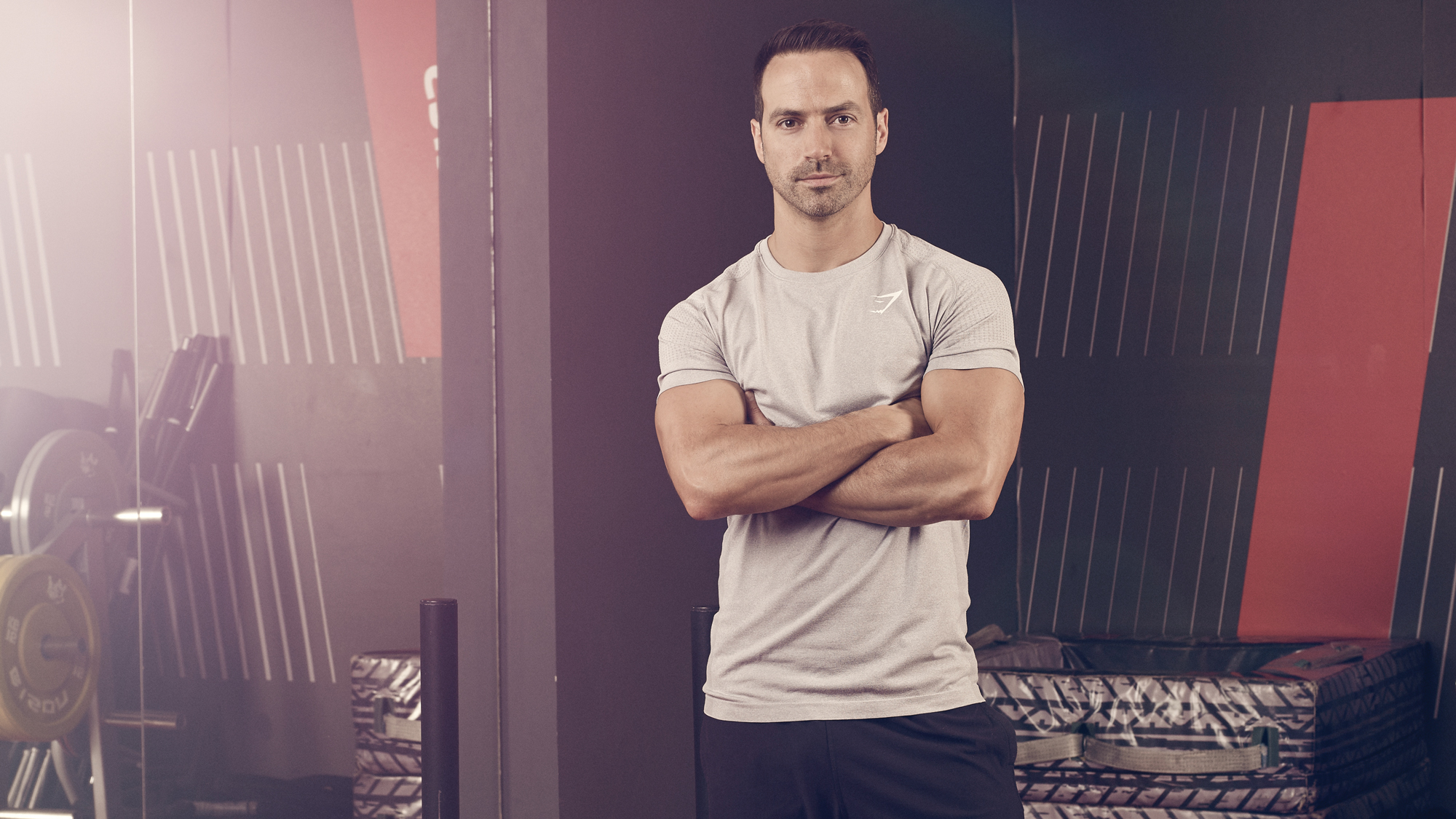Exclusive Paul Smith Interview
The British fashion legend on everything from his cycling background to creativity in modern design to his brand’s new fragrance

Photography: Sabine Villiard
Paul Smith didn’t want to be a fashion designer when he was growing up. He wanted to be a road cyclist like his hero, the Italian rider Fausto Coppi. “My love affair with bicycles and bicycle racing began on my 12th birthday, when my father bought me my first racing bike,” he tells Men’s Fitness backstage after his recent Paris Fashion Week Show. “He bought it from a man who was a member of the local cycling club, and I started going down there. I listened to the older members talking about the sport, I went out with them on training rides, and eventually I started competing in time trials and track races.”
While models and event staff scurry back and forth around us, and an increasingly anxious press officer fails to marshal the pack of international media vying for the main man’s attention, Smith remains an island of calm in a sartorial sea of chaos. In fact, everything about him seems out of step with the image-driven industry he inhabits.
“What I loved about cycling was the fact that it was a sport that was about working-class men with grit, determination and strength, which really appealed to me,” he says, leaning into the conversation as his suit crumples around the creases of his long, elegant frame.
Born in Beeston, a small town in the East Midlands, in 1946, Smith left school at 15 without any qualifications and went to work in a clothing warehouse. A cycling accident at the age of 17 broke his femur and, at the same time, shattered his dreams of becoming a pro rider. His first shop, which opened in Nottingham in 1970, only traded a couple of days a week because he had to do other jobs to pay for the stock and running costs. He did things the hard way. He did things his way. And almost five decades later, he’s worth an estimated £300 million.
He still owns the business and says retaining the values that brought him initial success is why the Paul Smith brand has endured while tastes and trends have evolved. That’s one of the reasons why we’re here today. His first menswear collection was shown in Paris in 1976 and he has remained loyal to the city offer since.
What are your memories of your first Paris collection?
I have such vivid memories of being in Paris to sell the collection for the first time. I had a tiny hotel room in the Odéon area. By night the room was where I slept and by day it became my showroom. I laid all the shirts out on the bed and hung the suit jackets on the back of the wardrobe door. For the first few days I didn’t have a single customer and then suddenly, on the last day, someone came by and that was the appointment that changed everything. I haven’t looked back since.
Get the Coach Newsletter
Sign up for workout ideas, training advice, reviews of the latest gear and more.
What is this latest collection about?
It’s about my history. As a young designer I studied tailoring. Couture fashion is very much about how you stitch things. What a dart does. How to put a shoulder in beautifully. One of my teachers was a military tailor. That’s about cutting the cloth and making the person look very regal and very important. I learned a lot from that. You may have noticed today that a lot of the trousers are very slim. It just gives height. And the way you put the waist into the shape of the coat or the jacket – it gives people a very nice shape.
You’re known for making suits. What does that particular garment mean to you?
I wear a suit every day. I like wearing a suit because you can wear it with trainers and a white T-shirt or with a shirt and tie. There’s so much sportswear out there, which we make and we do very well with, but so many brands are doing that now… It’s not in my heart. What’s in my heart is beautiful fabrics, playing with textures, playing with pattern and playing with proportion. You may have noticed that the tailored jackets in this collection are longer at the front than they are at the back, which gives you this elegance.
What gives a Paul Smith suit its identity?
We’re known for making classical items but with an element of surprise. I’m firmly of the belief, though, that if something isn’t broken you don’t fix it.
Speaking of which, you’ve been consistently popular for decades. How has that been possible?
We’re still an independent company. I left school at 15 and until the age of 17 I wanted to be a racing cyclist. After a bad crash I ended up meeting some kids from the local art school and became interested in fashion. But I’ve always been practical so when I opened a little shop it was only open two days a week and I supplemented my existence by doing other things. So over the years I got a great deal of experience of how to do things. And that’s meant I’ve been able to stay independent as a company when so many people from my era have been taken up by big groups.

For me, we’re still independent and we’re blessed with the ability to be spontaneous and experimental. I mean, the decision to do a show which is predominantly tailoring – if I was part of a big group we’d have to discuss the current trends or whether it’s good for the brand image. But I just go, “Let’s do tailoring!” And it works.
Has any element of your success been down to your competitive cycling background?
I rode in mass starts, not in time trials, and as a mass start rider you work as a team. You help the guy who is a good climber on the mountain day and you help the sprinter on the flat day. That’s what it’s like in business. I’ve got hundreds of staff and we play to strengths. I learned that through bike riding.
You’ve spent a lot of time with elite riders such as Bradley Wiggins and Mark Cavendish. Have you learned much from them?
Perhaps the passion for minute gains by doing something a different way. At 10am today I did a talk for about 300 of my staff who are here in Paris. And what I talked about was not going down the obvious route and instead thinking laterally, thinking in a different way. So yes, you could do things this way, but what if we tried this? What if we tried that?
How about the creative element? Do you have a particular process that you go through when you’re starting a project?
I go back to London tomorrow and the following day I’ve got my theme meeting for my next collection. Those themes might come from looking through books or looking at pictures I’ve taken. It could be of a tree. It could be graffiti. It could be of an old wall. Some texture. And then, I don’t know where it comes from, but I’ve just got loads of ideas written down on paper. It might just say, “butterfly wing colours” or it might say “graffiti”. Or, like in this collection, the idea is very much about rough and smooth and opposites.
The word you would have found in my notebook a year and a half ago was “irreverence”, which may end up as bike boots with a suit. Rough and smooth might mean shearling here and worsted wool there. I don’t really know where it all comes from.
How do you assess the general state of creativity in the industry?
Well, the problem is… no, not the problem, the point is it’s sad how concerned so may people are with what other people are doing. We’re all so obsessed with following each other. Possibly because we’re so over-informed with news and social media. We’ve almost got too much information. So in my industry it’s always, what did this brand do, what did that brand do? I say to my team, yes, you should know what they are doing, only to know what not to do!
Another thing you do differently is taking a lot of your own brand’s photography. What do the pictures have because you took them that they couldn’t have if an outsider were taking them?
I started taking photographs when I was 11 and my dad was an amateur photographer. That was when you used film, so I used to develop and print as well in a darkroom. And I’d have lovely conversations with my dad. He was very spontaneous. He loved the caught moment. And I’ve got a sense of humour. I’m quite an easy going person and I think that comes across in the photography. Another photographer might give you a beautiful photograph but it would probably be very contrived or very posed. Over the years I’ve said to some quite famous photographers, “I want humour” but they don’t seem to get humour.
When you were getting into cycling, and you’d see the black-and-white pictures that had that gritty romance to them, were you interested in the aesthetic side of the sport or was it just about going fast?
I loved the fact that, while of course your type of bike is important, it’s very much about your focus and your strength. Whereas with a car, say in formula one, it’s more that this team has done well this year because their car happens to be correct. Yes, you can get the seconds out of a good bike, but it’s always about you. And I’ve always been keen to have enough strength to make sure that I’m the one who always works harder or works a bit longer.

We understand that you go for an early morning swim every day. Is that right?
Yeah, at five o’clock. Every day. First of all, I like London early in the morning. I love to see the sun come up in summer. I swim for about 15 minutes and it stretches the body, clears your head. I get into the office at about six and there’s nobody there. You can get yourself sorted for an hour and a half and then slowly people start coming in.
You’ve been incredibly successful in your career. What do you think are the key ingredients of success, whatever the endeavour?
It’s all about getting the balance of all the ingredients right. Not getting lost in the creativity and making things that don’t sell, but also never standing still. Fashion is about today and tomorrow – I never forget that.
You’re just about to launch a new fragrance, Hello You. What are the key ideas in this latest scent?
Although this is a subtle scent, there is a very fresh twist too. That’s central to Paul Smith. The new fragrance has lovely notes of bergamot and vetiver, both of which remind me of the early part of my career, which was a time when they were particularly popular.
How important to you is the fragrance you’re wearing at any given time?
I like the idea of a fragrance that is a reflection of your personality. Generally speaking, for me that means more low-key, subtle fragrances. Some people choose to have different fragrances for different moments or even seasons, which I think is a very lovely way of relating to fragrance. There is so much power in a scent, it can be uplifting, or energising and always very personal to the wearer.
What should a Paul Smith fragrance embody?
The familiar with an element of the unexpected. Not overpowering in any way. A subtle aroma that the wearer can enjoy and keep returning to.
You seem to be a very happy person. Why do you think that is?
A few things. My father passed away when he was 94 and he was always friendly, always seemed to have lots of people around him. If you walked into a room he might be shy for two minutes but then the barriers would be broken down, so hopefully I’ve got some of his genes and some of his charisma in me.
And the other thing is that I’ve been with the same lady since I was 21. We’re very at ease with each other so I’m not searching for something. I’m not going through trauma. I’m blessed with patience. And I’ve learned good manners over the years. Good manners means you ask, you don’t tell. You say please and thank you. And if there’s something you’re not sure about you discuss it rather than just shout. And that makes for a happy ship.
We should probably mind our own manners and make this the final question. What does the Paul Smith brand mean to you?
Easy-to-wear clothes that are beautifully made. It stands for honesty. And what honest means is that I’ve got clients who have been with me for 25 years. There’s a safety in their minds. “I’ll find something at Paul’s shop.” You know, you don’t have to worry about it. My eyes will have sorted it out for you. So hopefully that’s true.
See related
Say Hello To The New Paul Smith Scent
“This fragrance has a strong personality but it’s not challenging,” says the fragrance’s co-creator Dominique Ropion. “It has a classical structure behind it but something unique inside. Classical structures have lasting appeal, but you have to find something new to give the fragrance personality.”
“When you make a fragrance for Paul Smith you need to have a funny and original touch,” says Fanny Bal, the scent’s other architect. “The idea was to signify the traditional British spirit but with a charming touch that represented the Paul Smith stripes. We started with a strong vetiver accord, which is a traditional woody smell. You have mandarin and bergamot for the freshness, coriander and pink pepper for spiciness. Then we added lighter touches like apple and lavender. The result is versatile – you can wear it during the day and in the evening.”
Paul Smith Hello You, £45 for 100ml, buy on paulsmith.com
Jon Lipsey worked for Men’s Fitness UK, which predated, and then shared a website with, Coach. Jon was deputy editor and editor from 2007 to 2013. He returned as editor-in-chief from 2016 to 2019. He also co-founded IronLife Media and the New Body Plan.

